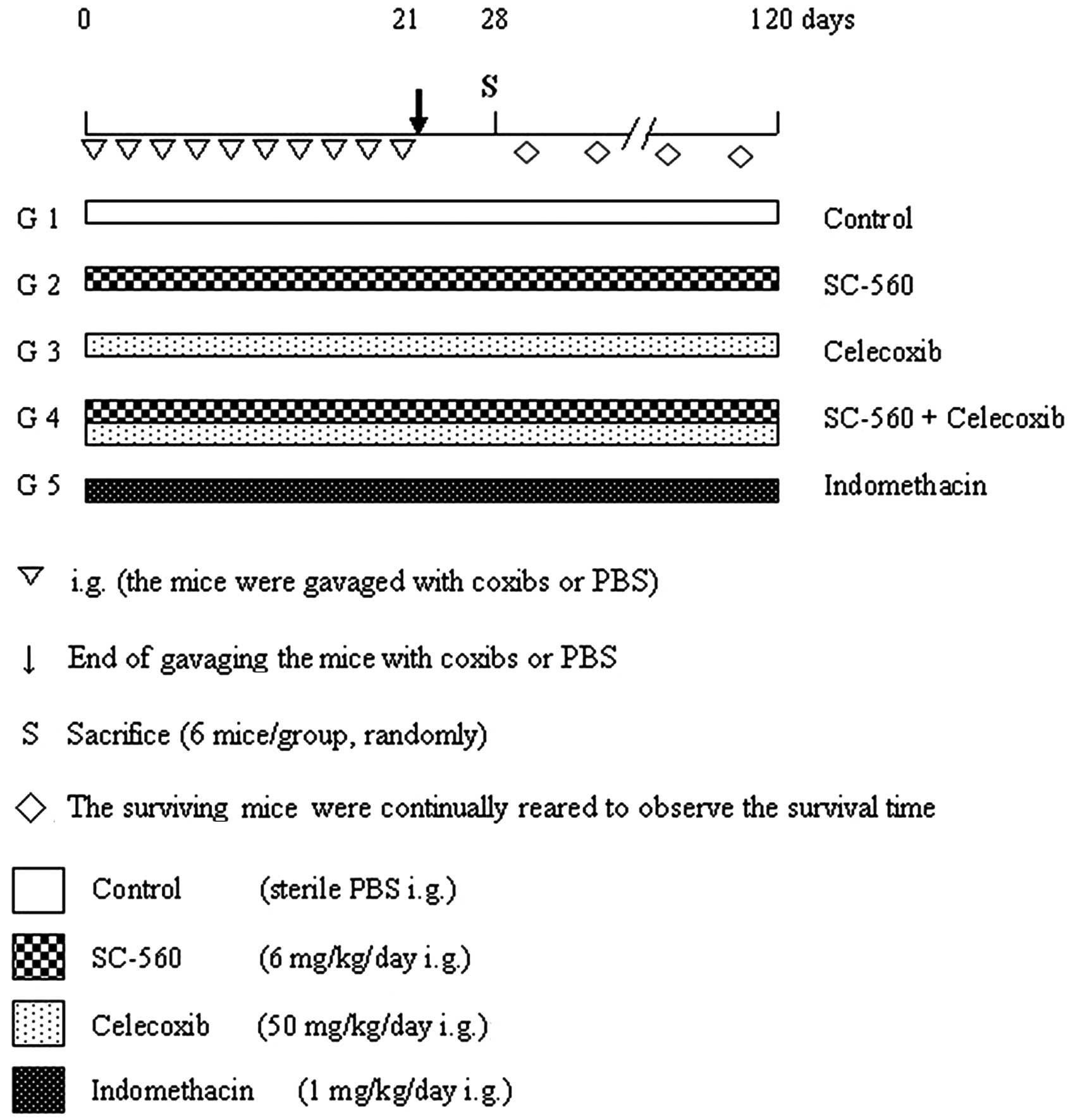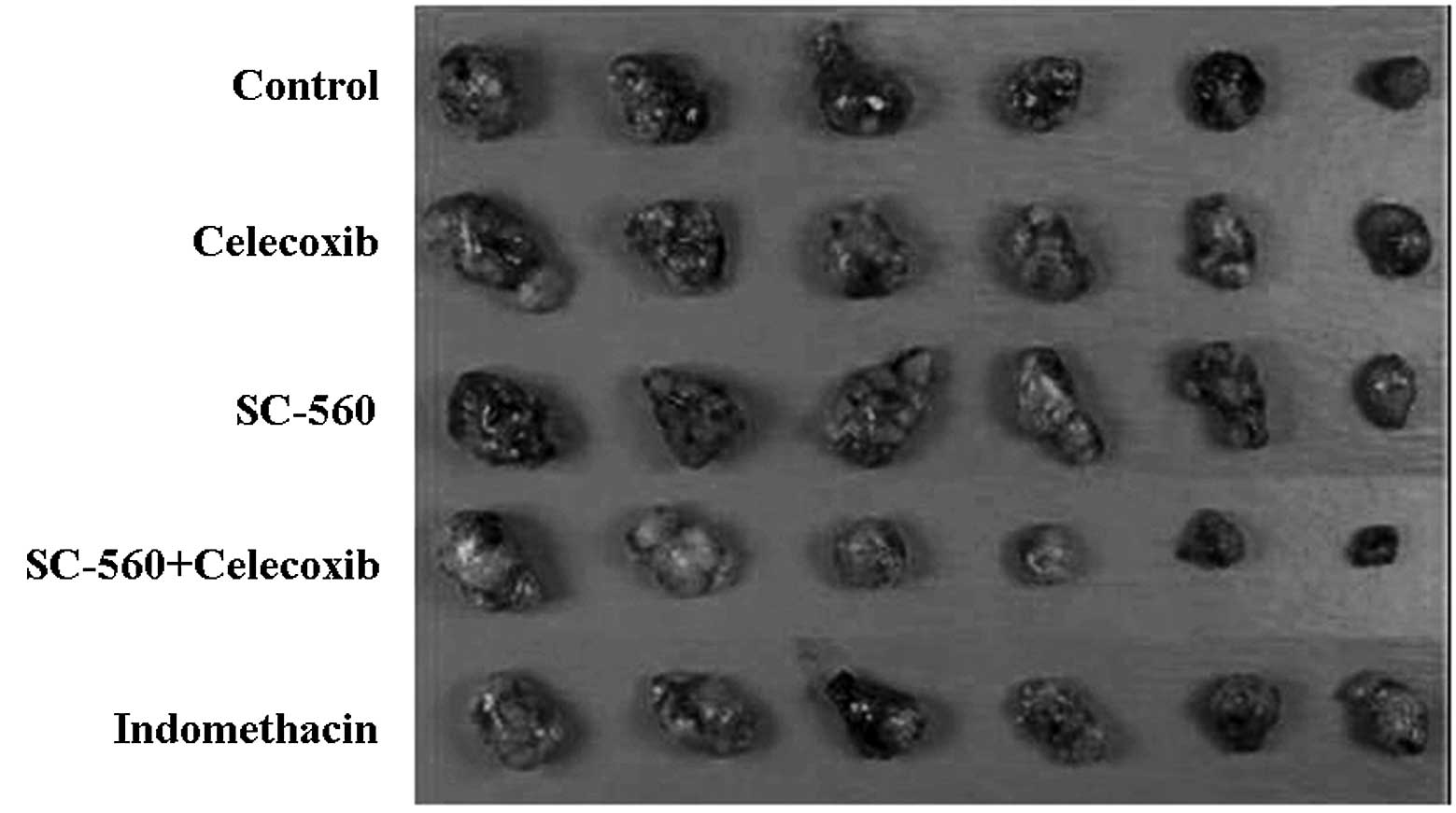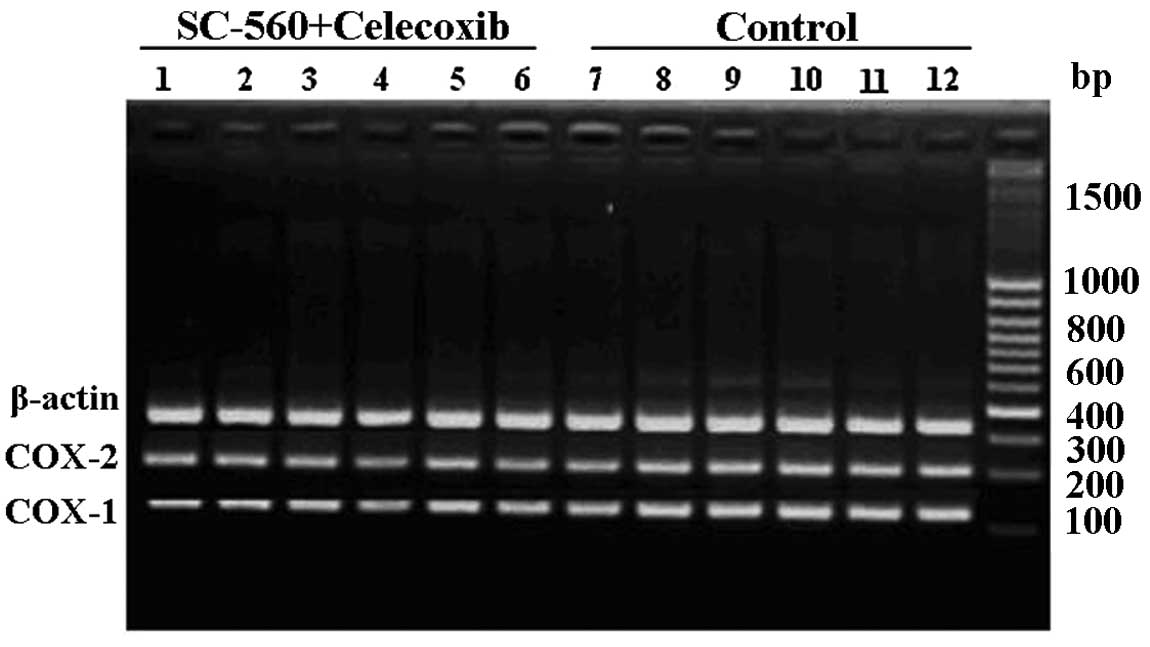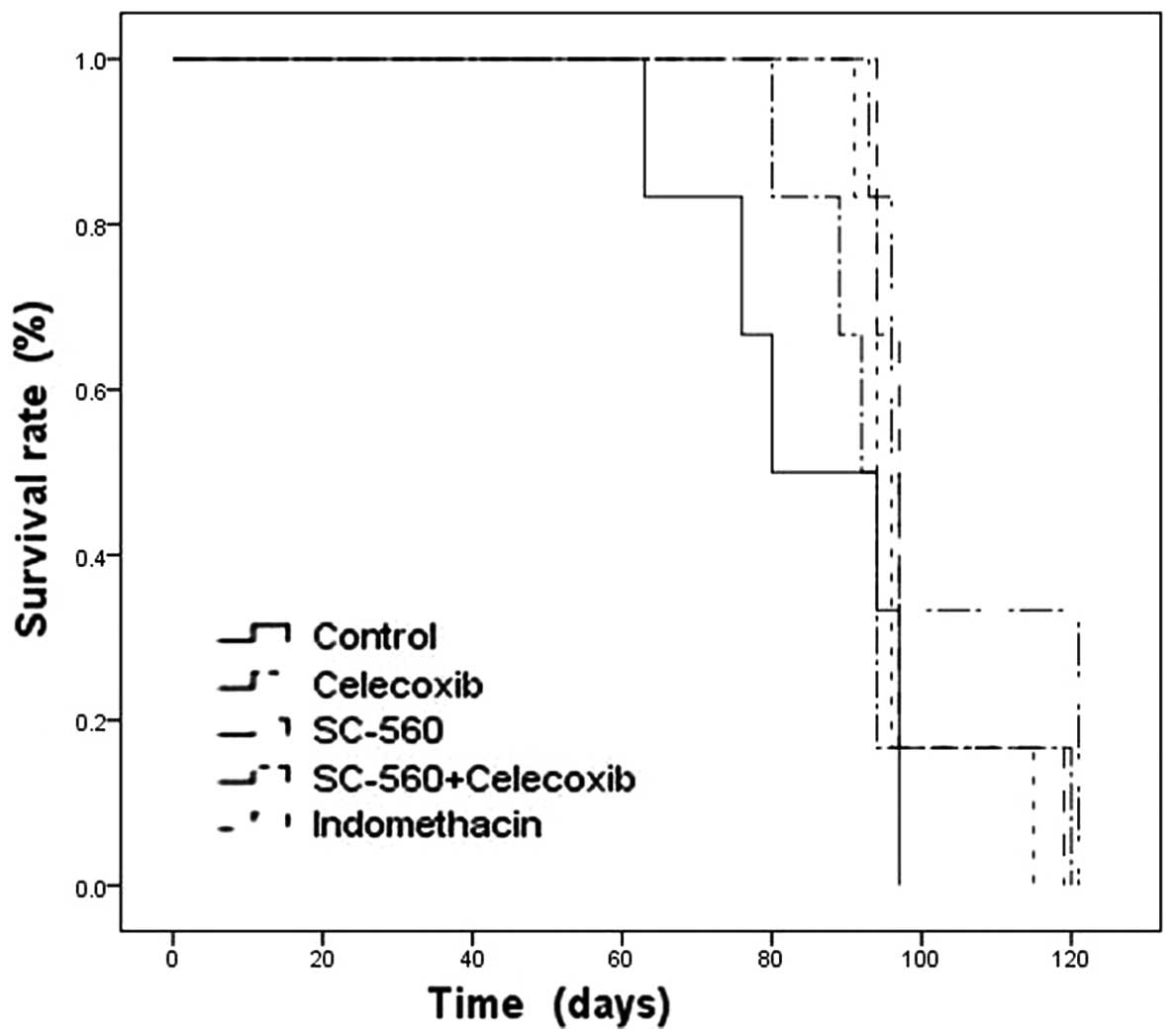Effects of cyclooxygenase inhibitors on survival time in ovarian cancer xenograft-bearing mice
- Authors:
- Published online on: September 20, 2012 https://doi.org/10.3892/ol.2012.929
- Pages: 1269-1273
Abstract
Introduction
Cyclooxygenase (COX) enzymes are key rate-limiting enzymes that catalyze prostaglandin (PG) synthesis from arachidonic acid. Two isoforms of COX enzymes have been identified and characterized. One of these forms, COX-1, is a housekeeping gene product that performs a homeostatic role and is expressed in a variety of tissues. The other isoform, COX-2, cannot be detected in the majority of normal tissues, but it can be induced by inflammatory stimuli including growth factors, cytokines and oncogenes. These two isoforms are encoded by two separate genes and exhibit distinct cell-specific expression, regulation and subcellular localization; however, they share similar structural and kinetic properties (1).
An expanding body of evidence demonstrates that COX-2 is overexpressed in a variety of malignancies including colorectal cancer (2,3), breast cancer (3), lung carcinoma (3) and ovarian cancer (4); while overexpression of COX-1 has been identified in human head and neck cancer (5) as well as ovarian cancer (6). Clinical and preclinical studies have indicated that COX-2 inhibitors are rapidly emerging as an excellent target for prevention and/or treatment of human cancers (7–10) due to their antiproliferative and antiangiogenic effects and their role in enhanced immune surveillance (8,9). Few studies have also concluded that COX-1 inhibitors are able to reduce tumor growth by decreasing cell proliferation and accelerating apoptosis (6,10). Additionally, COX-2 inhibitors have demonstrated potent life-prolonging effects in patients with esophageal and gastroesophageal junction cancer (11) and in various animal models of cancer (12,13).
On the basis of these findings, it was concluded that COX inhibitors (coxibs) are well-established chemopreventative drugs. Thus, in this study, we hypothesize that coxibs should markedly improve survival in ovarian cancer in vivo, possibly through inhibiting tumor growth. To examine this possibility, we studied the potential effects of SC-560 and celecoxib on survival time and tumor growth in an ovarian cancer xenograft-bearing mouse model.
Materials and methods
Human ovarian tumors in nude mice
The human ovarian carcinoma cell line SKOV-3 was used to appraise whether SC-560 and/or celecoxib were able to prolong the survival time by inhibiting ovarian cancer growth. SKOV-3 was purchased from China Type Culture Collection and grown in the recommended media under standard conditions. SKOV-3 cells were implanted subcutaneously in the dorsal skin (5×106 cells) of female athymic nude mice (BALB/cA, 40–45 days old). A tumor was successfully formed, and after three generations, a 1.5-mm3 well-developed tumor tissue was inoculated subcutaneously into the right axillary region of the mice. Treatment was initiated when the tumor became visible (average volume, 118.24 mm3). Mice were randomly separated into five groups (with 12 mice in each group) depending on their allocated treatment: SC-560, celecoxib, SC-560/celecoxib (combination group), indomethacin or control. The experimental design is shown in Fig. 1. The study was approved by the ethics committee of Nanjing Medical University of Hangzhou Hospital, Hangzhou, China.
The COX-1-selective inhibitor (SC-560; Sigma-Aldrich, St. Louis, MO, USA), COX-2-selective inhibitor (celecoxib; Pfizer, New York, NY, USA), and nonselective coxib (indomethacin; Sigma-Aldrich) were administered via gavage in a 0.5 ml suspension of 5% methylcellulose and 0.025% Tween-20 twice a day to achieve a dose of 6 mg/kg/day SC-560, 50 mg/kg/day celecoxib and 1 mg/kg/day indomethacin. The doses were selected for their specificity in inhibiting COX isotypes (14). The control group of mice were treated with sterile PBS (pH 7.2), while the selected doses of coxibs were administered to the SC-560 alone, celecoxib alone, SC-560 in combination with celecoxib, indomethacin alone and the control group every other day for a period of 21 days, beginning on the day when the tumors became palpable. Mice were maintained on a standard diet and water was made freely available.
The tumor dimensions were measured twice a week using a linear caliper, and the tumor volume was calculated using the equation V (mm3) = 1/2 x a x b2, where a and b are the largest and the smallest perpendicular diameters (15), respectively. These results are used to calculate the relative tumor volume (RTV) using the equation RTV=Vt/V0, where V0 is tumor volume on the day of first administration and Vt is the total for each measurement of tumor volume. The animals were weighed weekly throughout the experiment. In order to observe the effect of the coxibs on tumor growth, half of the mice in each group were sacrificed randomly on day 28. All tumor tissue samples were then collected and fixed in 10% phosphate-buffered formalin solution for molecular biology or snap frozen in liquid nitrogen and stored at −80°C for further analysis. The remaining mice were continually reared with a basal diet to observe the survival time, and the study was continued until all mice had been sacrificed (day 121).
Reverse transcription-polymerase chain reaction (RT-PCR)
To investigate the expression of COX-1 and COX-2 mRNA levels in the human ovarian carcinoma cell line SKOV-3, the coxib treatment groups and the control group were analyzed for the expression of COX-1 and COX-2 mRNA using RT-PCR. Total RNA was isolated from the tissue using TRIzol reagent (Invitrogen Life Technologies, Carlsbad, CA, USA). Total RNA (5 μg) was reverse transcribed using the SuperScript-II according to the manufacturer’s protocol (Invitrogen Life Technologies). PCR for COX-1, COX-2 and β-actin was carried out in a 50-μl reaction mixture containing 5 μl aliquots of reverse transcribed cDNA samples, 1X PCR buffer, 1.5 mM MgCl2, 0.2 mM dNTP, 2.5 units Ampi-Taq DNA polymerase and 400 nM primers. PCR was run for 40 cycles, which consisting of denaturation at 94°C for 30 sec, annealing at 54°C for 30 sec, extension at 72°C for 45 sec and final extension at 72°C for 5 min. A constitutively expressed β-actin gene was used as a control with PCR conditions identical to that for COX-1 and COX-2. The primers for COX-1 were 5′-cctcaccagtcaatccctgt-3′ (sense) and 5′-gggcagtctttgggtacaga-3′ (antisense), and those for COX-2 were 5′-tcctcccgtagcaga tgact-3′ (sense) and 5′-aagtggtaaccgctcaggtg-3′ (antisense). The primers for β-actin were 5′-ttgctgacaggatgcagaag-3′ (sense) and 5′-acatctgctggaaggtggac-3′ (antisense).
Statistical analyses
All results were expressed as the mean ± standard error (SE). We used the Dunnett’s test and the log-rank test based on the joint-ranking method for evaluation of the inhibitory activity on tumor growth and life-prolonging activity, respectively. Additionally, to evaluate the life-prolonging effect of the coxibs, the median survival time (MST; days) for each group following tumor inoculation was determined from the survival times of the mice according to the Kaplan-Meier plot using the SPSS system 17.0 (SPSS, Inc., Chicago, IL, USA). P<0.05 was considered to indicate a statistically significant difference.
Results
Effect of coxibs on tumor growth
Following tumor establishment, 12 mice in each group were treated with SC-560, celecoxib, SC-560/celecoxib or indomethacin. Treatment was continued for 21 days. To examine whether the life-prolonging activities of COX-1 and COX-2 selective inhibitors were caused by their inhibitory effects on tumor growth, six randomly selected mice in each group were sacrificed on day 28. Tumor growth was evaluated by measuring the RTV, as shown in Fig. 2. On day 21, at the end of treatment, the RTV was 6.42±2.60 in the SC-560 group. Under similar conditions, the RTVs were 4.69±2.93, 5.75±2.15, 5.96±2.07 and 6.23±1.97 in the SC560/celecoxib, celecoxib, indomethacin and control groups, respectively. Combination therapy resulted in a statistically significant inhibition of tumor size compared with the vehicle-treated control group (P<0.05). On day 28, to assess the growth-inhibitory effect of coxibs, six randomly selected mice in each group were sacrificed, and tumor tissue samples were collected and photographed (Fig. 3). No toxicity was observed in any of the mice, as measured by weight gain/loss as well as gross pathological examination of the gastrointestinal tract of the mice at necropsy.
COX mRNA expression
To investigate whether the coxibs regulated COX-1 or COX-2 expression in ovarian carcinoma xenograft-bearing mice, all collected tumor tissue samples in the combination and control groups were analyzed for differential expression of COX-1 and COX-2 mRNA by RT-PCR analysis. The analysis revealed that following treatment with celecoxib and SC-560, the presence of COX-1 and COX-2 mRNA was reduced, while they were distinctly evident in untreated tumor samples (Fig. 4).
Effect of coxibs on survival
To observe the effect of coxibs in improving survival, after day 28 the remaining six mice continued to be reared with a standard diet and water. The mice were closely monitored and studies were terminated when all mice were sacrificed on day 121 due to the level of burden caused by the tumor. In the vehicle-treated control group, the first and last mice were sacrificed on days 63 and 97, respectively, and the mean survival time was 84.50±5.65 days. In the coxibs-treated groups, the first mouse was sacrificed on day 80, as in the SC560+celecoxib group, and the last mouse was sacrificed on day 121, in the celecoxib group. The coxibs monotherapy or combination therapy groups resulted in a trend toward extending the survival time in comparison to the control group (Fig. 5). Celecoxib or SC-560 treatment alone markedly prolonged the mean survival time of xenograft-bearing mice in comparison with the control group (P<0.05; Table I). Particularly in the celecoxib group, the mean survival time was extended to 104.00±5.40 days. The last mouse to be sacrificed (on day 121) was also in this group. To evaluate the life-prolonging effect of coxibs, the MST for each group was determined. MST is the estimated time from diagnosis when 50% of the mice died, and is measured using the Kaplan-Meier estimate of survival. MST for each coxib-treated group was significantly longer in comparison with the vehicle treated control group (Table I).
Discussion
The present study was designed to assess whether coxibs are able to prolong the survival time of nude mice transplanted with the human ovarian cancer SKOV-3 cell line. This study revealed that the survival probability was extended following coxib therapy. Celecoxib or SC-560 treatment alone demonstrated a significantly prolonged mean survival time and MST in comparison with the control group in vivo.
Recent clinical studies have provided convincing evidence of poor survival in patients who demonstrated high COX-2 expression in stage IIB cervical adenocarcinoma and breast cancer (16,17). Erkinheimo et al (18) suggested that elevated expression of COX-2 is associated with reduced survival in serous ovarian carcinomas. Another clinical study by Denkert et al (4) using univariate and multivariate analyses indicated that the expression of COX-2 in patients with ovarian carcinomas is a predictor of short survival times. Based on these findings, researchers have focused their attention on coxibs and survival in tumors. In a phase 2 trial, celecoxib treatment improved overall survival in patients who suffered from COX-2-positive esophageal and gastroesophageal junction cancer (11). In colorectal adenocarcinoma, CS-706, a novel COX-2 selective inhibitor, was demonstrated to have potent life-prolonging activity in tumor-bearing mice (12). In ovarian cancer, Xin et al (13) identified that meloxicam, categorized as a selective COX-2 inhibitor, prolonged survival in vivo when administered alone. However, studies concerning the correlation of COX-1 and survival are rarely reported. In the present study, we reveal that celecoxib and SC-560 prolong survival in a mouse xenograft model. Our results are similar to those of Sorenmo et al (19) which demonstrated that dogs with prostatic carcinoma treated with coxibs (piroxicam or carprofen) lived significantly longer than untreated dogs.
Additionally, we attempted to find the correlation between survival time and tumor growth. We examined the antitumor activity of coxibs on tumor growth, and we observed that a combination of SC-560 and celecoxib resulted in a significant inhibition of tumor size in comparison with the control group. In the same study (20), we identified that combined coxib therapy produced significant potential synergistic suppressive effects on tumor growth in comparison with the same doses of either SC-560 or celecoxib following 14 days of treatment. This was in accordance with the results from Kitamura et al (21) who revealed that combination therapy with mofezolac (a COX-1 selective inhibitor) and nimesulide (a COX-2 selective inhibitor) has particular potential for chemoprevention of colon carcinogenesis compared with the effects of either coxib as monotherapy. In their study, the number of polyps more than 2.5 mm in diameter was markedly decreased by combined coxib treatment. We also observed that SC-560 or celecoxib, as a single agent, had a decreasing tendency in tumor growth, which was in accordance with other studies demonstrating SC-560 or celecoxib suppression of tumor growth in mouse models of ovarian cancer (6,22). Taken together, we considered that coxibs were able to prolong survival time by attenuating tumor growth in ovarian cancer. We observed that suppressive effects on tumor growth were markedly exhibited following 14 days of treatment. For this reason, on day 28, six randomly selected mice from each group were sacrificed to observe the effect of coxibs on tumor growth, and the last six mice were reared to record the survival time. Our novel findings suggest that tumor growth was inhibited in each therapeutic group, which resulted in the prolonged survival of mice. Although multiple molecular and cellular mechanisms are involved in exerting the antitumor effects of coxibs, the mechanisms by which coxibs extend survival are currently unclear. Yao et al (23) suggested that selective or nonselective coxibs improved survival in mouse models of colorectal cancer by modulating tumor angiogenesis.
Increasing levels of COX-1 and COX-2 mRNA have been observed in ovarian cancer (18,24). Several studies have reported that COX-1 and COX-2 are concurrently overexpressed and play an important role in the pathogenesis of ovarian cancer (4,25). In the present study, RT-PCR results revealed that COX-1 and COX-2 mRNA expression levels were increased in untreated tumors, but were decreased in the combined treatment tumors. In the same study, using western blotting analysis, we identified that COX-1 and COX-2 protein levels were reduced in the combination group cells in comparison with those in the control group (20). The reason for the inhibition of COX-1 and/or COX-2 mRNA and protein expression in neoplastic tissues may be due to the inhibition of angiogenesis, induction of apoptosis and/or antiproliferative effects (6,8,10). The antitumor effects of coxibs have long been suggested to depend on the inhibition of COX activity and PG synthesis. PGE2 is produced from arachidonic acid by one of two enzymes: COX-1 or COX-2. There is increasing evidence that PGE2 contributes to tumor progression by promoting tumor angiogenesis and inducing tumor cell apoptosis (8,26,27). Our same study that focused on the potential mechanisms revealed that coxibs suppress ovarian tumor growth by influencing cell proliferation and apoptosis (20). These results suggest that the inhibition of COX-1 and/or COX-2 is able to slow tumor growth, the beneficial effects of which may prolong survival time.
In conclusion, the present study suggests that the prolonged survival of coxib-treated animals is most likely the result of suppressing tumor growth through multiple mechanisms, including antiproliferative and apoptosis effects in vivo. However, the exact mechanism of life-prolonging activity requires further study.














